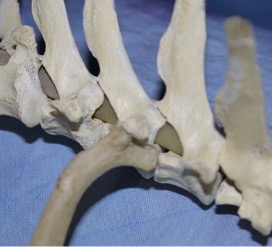| print
link to this post | email a friend Signs of Rib Pain in Your Dog08 Nov 2022 By Laurie Edge-Hughes, BScPT, MAnimSt (Animal Physio), CAFCI, CCRT
Rib pain isn’t typically something you think about when you watch your dog move about. The rib joints aren’t something you think can be injured. However, they most certainly can! And while some dogs are good at hiding rib discomfort and/or overriding that discomfort, sometimes there are clues that rib pain exists.
Firstly, let’s look at the rib joints.
The rib joins the spine in 4 places. For most of the ribs, the head of the rib meets up with two vertebral bodies, the disc in between, and a transverse process. And all of these joints are bound together by ligaments. So, there are plenty of places where things can go wrong!
What causes a rib problem? Crashing, bashing, and wresting with other dogs is high on the list of ways that ribs can get knocked about. Sometimes there’s a history of falling down stairs, or off of a high surface, or just slipping and tripping. We also see it in the canine athletes who ‘go, go, go’ and subject themselves to uneven surfaces, sharp turns, screeching halts, and speed!
What happens with this trauma? Well, ribs don’t ‘go out’. It might feel like they do! However, what tends to happen is a pressure build up within the joint, and abnormal signalling of the nerves that feed information to and from the joints, which leads to pain and an increase in muscle tension in the area.
What do these dogs look like? As stated above, sometimes, you can’t tell that a dog has a rib issue by watching them. Other times, the clues can be more subtle: stretching more often, discomfort changing position, slowing down in sporting events, avoidance of jumping down, standing crooked, or even a subtle front leg lameness (depending on where the rib problem is situated). We’ve had smaller dogs or puppies that are less tolerant of being picked up. It’s not just one ‘look’ that we’ve noted over the years.
What can be done about it? Physiotherapists with training in canine rehab have a multitude of manual techniques they can use to move these joints. Essentially by moving the joint(s), there can be a change of pressure within the joint and a dampening of the pain signalling from the joint. If the area is not acutely painful, then techniques that involve stretching the ligaments around the joints will often do the trick. So, the therapist might employs techniques where they press on the ribs or lift the ribs. They might add in some myofascial techniques to settle down the muscles and maybe some laser therapy to reduce the pain as well.
The result? We’ve seen resolution of lameness and normalization of posture and movements. It’s fun to find and fix these issues in sporting dogs, because here is where we learn (after the fact) how the rib issue was causing a performance issue. We’ve had owners of the canine athletes report that their dogs became faster, or were better at weave poles. Sometimes owners report that they hadn’t realized that their dog had stopped doing things like jumping onto their bed or engaging in ‘silly runs’.
The final message Maybe one of the scenarios above resonated with you as an issue that you’ve seen in your dog. Perhaps not. However, it’s one reason why we recommend periodic check-ups on dogs. We’re always amazed at what we find, and one of those findings just might be rib pain!
We hope this gets you thinking, and we’d love to see you and your pooch (or cat) someday soon!
|

|

